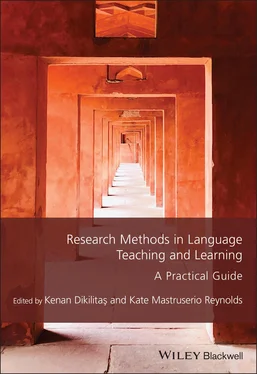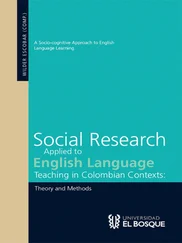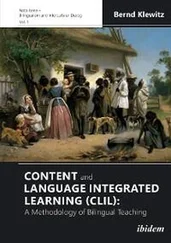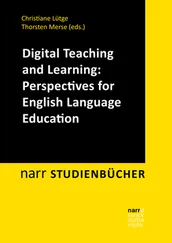Research Methods in Language Teaching and Learning
Здесь есть возможность читать онлайн «Research Methods in Language Teaching and Learning» — ознакомительный отрывок электронной книги совершенно бесплатно, а после прочтения отрывка купить полную версию. В некоторых случаях можно слушать аудио, скачать через торрент в формате fb2 и присутствует краткое содержание. Жанр: unrecognised, на английском языке. Описание произведения, (предисловие) а так же отзывы посетителей доступны на портале библиотеки ЛибКат.
- Название:Research Methods in Language Teaching and Learning
- Автор:
- Жанр:
- Год:неизвестен
- ISBN:нет данных
- Рейтинг книги:5 / 5. Голосов: 1
-
Избранное:Добавить в избранное
- Отзывы:
-
Ваша оценка:
- 100
- 1
- 2
- 3
- 4
- 5
Research Methods in Language Teaching and Learning: краткое содержание, описание и аннотация
Предлагаем к чтению аннотацию, описание, краткое содержание или предисловие (зависит от того, что написал сам автор книги «Research Methods in Language Teaching and Learning»). Если вы не нашли необходимую информацию о книге — напишите в комментариях, мы постараемся отыскать её.
Research Methods in Language Teaching and Learning
Research Methods in Language Teaching and Learning
Research Methods in Language Teaching and Learning — читать онлайн ознакомительный отрывок
Ниже представлен текст книги, разбитый по страницам. Система сохранения места последней прочитанной страницы, позволяет с удобством читать онлайн бесплатно книгу «Research Methods in Language Teaching and Learning», без необходимости каждый раз заново искать на чём Вы остановились. Поставьте закладку, и сможете в любой момент перейти на страницу, на которой закончили чтение.
Интервал:
Закладка:
My own study aligned with the paper-and-pen approaches that still predominate among the relatively limited number of diary-based research into language teaching and learning (e.g., Gkonou, 2012; Huang, 2005; Yi, 2008). In my project, the teacher and learners were provided with notebooks in which to record their experiences and thoughts about their lessons each day, which I read and returned on a daily basis (the project was thus broadly event-contingent, although there was some flexibility within this approach, with diarists being free to record their experiences at any time following a class but prior to their next lesson). The intention was to develop among participants a sense of “ownership” of the diaries, both as a process and as a product. More practically, collecting the diaries each day enabled the subsequent follow-up interviews to be more contemporaneous, with the classroom events being discussed, while also, I intended, maintaining and enhancing diarist participation and involvement over the course of the project (for further discussion of maintaining diarists’ participation, see below).
Paper and pen aligned with the expectations and abilities of these literate, upper-intermediate/CEFR B2 English learners and their teacher, and avoided the need for the further transcription needed with audio- or video-diaries; reporting took place in English for the practical reason that I could not myself translate the required languages, but with effects upon the data which are unclear. It may, of course, have limited the ability of some diarists to convey their experiences and perspectives as effectively as they would have liked (the project’s regular follow-up interviews with the diarists went some way in addressing this concern); alternatively, however, communication in a second or foreign language might hinder obfuscation more than it hampers articulacy, to the benefit of my research (for further discussion of the data and issues surrounding data analysis, see below). Finally, and from a somewhat mundane perspective, yet one that is important in all research projects, paper and pen was also a format that was in keeping with the study’s relatively limited budget. Undertaken before the now widespread use of smartphones, it was impossible to provide participants with the necessary number of individual audio- or video-recording devices during the research.
Maintaining Participation
As we have seen, keeping a diary in any form requires diarists to expend time and effort as, in order to obtain high quality and regular data, diary studies require a level of participant dedication “rarely required in other types of research studies” (Bolger et al., 2003, pp. 592–593). Thus, the overall duration of my project, and the detail required and regularity with which diary entries were to be made, had implications for the diarists’ retention or drop-out from my study. The dilemma I faced in the design of the study, therefore, was that reducing the period over which participants would maintain their diaries and lessening the effort they required to keep them, thereby encouraging and maintaining their contribution to the research, would most likely be at the expense of the quality and quantity of the data that was recorded.
As ever, the few published diary-based research into language teaching and learning addressed the issue in a variety of ways. Studies by Halbach (2000) and Huang (2005) into learners’ strategies for learning, for example, were relatively long, lasting “a term” and 18-weeks respectively. However, in both cases, the diaries were part of the learners’ course requirements creating a context, perhaps, in which maintaining participation over such a lengthy period was possible. Such an option was not available in my own research. Meanwhile, Lopera Medina’s (2013) investigation into the teaching of reading also lasted a term (120 hours of teaching), but only the teacher was required to complete a diary, presumably due to the significant time and effort this required, and the teacher’s level of commitment – it is difficult to envisage a group of learners such as those in my research (or, indeed, any larger cohort of research participants) participating in a diary study consistently and in detail over such a timespan. Meanwhile, of the limited number of diary studies which have focused on groups of learners (rather than individual students), but have not embedded diary-keeping into the course requirements, Gkonou’s (2012) investigation of learner anxiety required diarist participation for 8 weeks, with the researcher collecting and reading the diaries on a weekly basis.
Drawing both on these published insights and the practicalities underpinning my own project, therefore, data collection in my investigation consequently lasted for a period of 4 weeks, with participants completing their diaries on a daily basis after lessons (as previously noted). This timescale and level of detail attempted to balance the aims of my research with a realistic perspective of what participants could be asked to undertake. As we have already seen (see “Finding Participants”), the project was voluntary and thus the diaries were an addition to the participants’ already busy lives, both within the classroom and beyond.
Yet the risk remained that, although this approach appeared to be appropriate for the study, participants might still produce superficial or incomplete data, or drop out of the research entirely. Thus, it was important that my guidelines to the diarists were clear – that they knew what was required and what they were committing to (see earlier discussion for the complexities of balancing my project’s aims and search for relevant data with the freedom needed for participants to express their own priorities and perspectives). Furthermore, I was present and available within the research setting (i.e., the school) as data collection started, enabling me to check my instructions with the participants on a face-to-face basis and answer the few queries that emerged (for example, refining my guidelines at the diarists’ request; see “Structured or Unstructured Diaries?” above). Additionally, I was able to check a sample diary entry for each diarist early in the study, reassuring them as to its value to the research (Hall, 2008; see also Alaszewski, 2006). Diarists are more likely to be confident from the outset in what they are doing if they can see it meets the needs of the research. This confidence and clarity consequently supports and enhances their participation in a project, while confusion is clearly demotivating.
Moreover, pursuing a diary approach in conjunction with other methods of data collection also provided me with the opportunity to further develop the constructive researcher–participant relationships that were so central to maintaining the diarists’ participation in the study. In the diary-interview method that I pursued, participant diaries were collected and read on a daily basis as the starting point for follow-up interviews. The interviews, also daily, further explored the diarists’ reported experiences and perspectives on classroom life, participation in the interviews thereby reinforcing, for the diarists, the value of their perspectives for my own understanding of their classroom, and highlighting, for them, the importance of their contribution to the project. In the interviews, the participants and I could also identify and iron out any final methodological difficulties within the project (see also Zimmerman & Wieder, 1977), again helping to maintain their participation in the research.
Finally, I needed to consider whether the diarists should be paid or otherwise rewarded for their participation in my study. Small payments and rewards are often budgeted for and deployed as a practical means of recruiting and maintaining the participation of diarists (e.g., Kuntsche and Robert’s, 2009, work with young adults), yet some argue that such payments reinforce unequal power relationships (e.g., Ansell, 2001). Clearly, researcher beliefs and research context as well as resource availability will affect the way this issue is managed. Yet in keeping with the majority of published language teaching and learning studies, and taking account of the relatively “resource-light” approach of my project, my diarists were not in fact rewarded for their participation. Given the steps I had taken to develop with the participants a clear understanding of the project and its requirements, and the positive relationships with the diarists that I worked to develop, I hoped that the act of keeping a diary and contributing to research would be rewarding enough in and of itself to encourage and maintain effective participation over time. Fortunately, these hopes were justified and all 13 participants continued to participate throughout the course of the research.
Читать дальшеИнтервал:
Закладка:
Похожие книги на «Research Methods in Language Teaching and Learning»
Представляем Вашему вниманию похожие книги на «Research Methods in Language Teaching and Learning» списком для выбора. Мы отобрали схожую по названию и смыслу литературу в надежде предоставить читателям больше вариантов отыскать новые, интересные, ещё непрочитанные произведения.
Обсуждение, отзывы о книге «Research Methods in Language Teaching and Learning» и просто собственные мнения читателей. Оставьте ваши комментарии, напишите, что Вы думаете о произведении, его смысле или главных героях. Укажите что конкретно понравилось, а что нет, и почему Вы так считаете.












